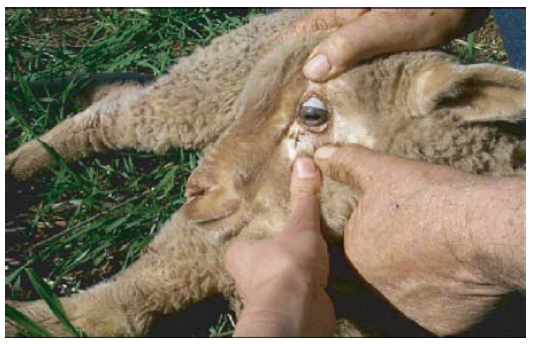Anaemic sheep warning
 PRODUCTION ADVICE - OCTOBER 2020 - ANIMAL BIOSECURITY & WELFARE
PRODUCTION ADVICE - OCTOBER 2020 - ANIMAL BIOSECURITY & WELFARE
By Eve Hall
District Veterinarian
P: 0439 078 989 | E: eve.hall@lls.nsw.gov.au
District vets in the region have seen the odd case of anaemia in sheep lately and are urging producers to keep a keen eye out for signs of disease.
Signs of anaemia in sheep can include:
- Pale gums and mucous membranes
- Weakness, or lagging behind in the mob
- Trouble breathing or staggering when pressured
- Jaundice – ‘yellowing’ of the gums
- Death, often when stressed by yarding or handling.
What can cause anaemia in sheep?
The most common causes of anaemia in sheep that we see in this region now and into the coming months are barber’s pole worm, and Mycoplasma ovis.
Barber’s pole worm is a blood-sucking parasite that attaches to the gut lining of sheep. High numbers can lead to anaemia, weakness and death. On some occasions death due to barber’s pole worm can be quite sudden, with few, if any, signs seen before death. Unlike other intestinal worms, diarrhoea and weight loss are not necessarily seen. Barber’s pole worm thrives in warm wet conditions, so an anticipated wet summer may well see problems arise.
You should perform regular worm tests to get an indication of the worm burden levels in each mob. Barber’s pole worms are prolific egg producers, so worm egg counts in the thousands can be a strong indication.
 Mycoplasma ovis (or Eperythrozoonosis - see photo, right) is another sporadic disease that can also cause anaemia in sheep. Mycoplasma ovis is a bacterium that damages red blood cells, leading to anaemia and death when stressed by yarding or handling.
Mycoplasma ovis (or Eperythrozoonosis - see photo, right) is another sporadic disease that can also cause anaemia in sheep. Mycoplasma ovis is a bacterium that damages red blood cells, leading to anaemia and death when stressed by yarding or handling.
The disease is often spread via infected blood on equipment at vaccinating and marking. Spread can also occur via blood-sucking parasites and insects such as mosquitos, which may be very active this summer given recent and anticipated wet conditions.
Younger sheep are more at risk, as older sheep tend to have developed immunity to the infection. Outbreaks are typically seen around 4-6 weeks after marking, mulesing or shearing of young sheep. Time and minimisation of stress is the only treatment.
What to do if you are suspicious of anaemia in your sheep
Don’t panic or rush them straight to the yards for a drench! You could risk losing large numbers due to the associated stress.
Start with a low-stress paddock worm test. If the worm count is very high, then the problem is likely barber’s pole worm and, after discussion with a vet, careful yarding for drenching may be indicated. If the worm count rules out worms, then it could be Mycoplasma ovis. Discuss with a vet on how best to proceed.